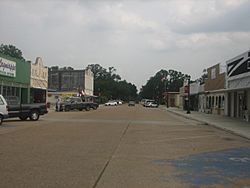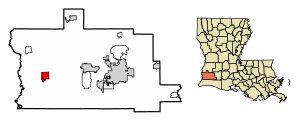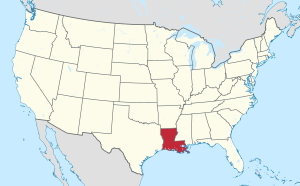Vinton, Louisiana facts for kids
Quick facts for kids
Vinton, Louisiana
|
|
|---|---|
|
Town
|
|

Downtown Vinton
|
|
| Motto(s):
Louisiana's Gateway to Cajun Country
|
|

Location of Vinton in Calcasieu Parish, Louisiana.
|
|

Location of Louisiana in the United States
|
|
| Country | United States |
| State | Louisiana |
| Parish | Calcasieu |
| Area | |
| • Total | 5.15 sq mi (13.33 km2) |
| • Land | 5.10 sq mi (13.22 km2) |
| • Water | 0.04 sq mi (0.12 km2) |
| Elevation | 16 ft (5 m) |
| Population
(2020)
|
|
| • Total | 3,400 |
| • Density | 666.27/sq mi (257.24/km2) |
| Time zone | UTC-6 (CST) |
| • Summer (DST) | UTC-5 (CDT) |
| ZIP code |
70668
|
| Area code(s) | 337 |
| FIPS code | 22-78820 |
Vinton is a town located in Calcasieu Parish, Louisiana, United States. A "parish" in Louisiana is like a county in other states. In 2020, about 3,400 people lived here. Vinton is part of the larger Lake Charles area, which is a "metropolitan statistical area." This means it's a region with a large city and smaller towns connected to it.
Contents
Exploring Vinton's Past: A Look at Its History
The area where Vinton now stands was once part of the "Old Spanish Trail." This trail was hard to travel because the ground was often muddy. Most travel in the region happened on riverboats. These boats used the Sabine and Calcasieu rivers. This made it easier to get to places like Lake Charles.
Early Settlers and Disputed Lands
One of the first pioneers in the Vinton area was Jean Baptise Granger. He settled land near Vinton around 1827. For many years, this part of Louisiana was a disputed area. France, Spain, and Mexico all claimed it. When the United States bought Louisiana, they also inherited this land dispute.
American and Spanish leaders made an agreement to call it "neutral ground." It was also known as the Neutral Strip. No soldiers from either country were allowed there. Settlers were not supposed to be there either, but many people moved in anyway.
Transportation and the Civil War Era
People tried to improve travel routes in the 1800s. In the 1830s, Dr. Robert Neblett created a busy river port. It was called Niblett's Bluff, about 6 miles (9.7 km) west of Vinton. During the American Civil War, Niblett's Bluff became Fort Niblett.
Confederate soldiers built a military road from there to Alexandria in 1863. This fort helped the Confederates win the Battle of Mansfield. Today, Niblett's Bluff Park remembers this important place.
The Arrival of the Railroad and New Industries
Vinton might have stayed a small, quiet place without two big changes. First, Charles Morgan's railroad companies built a railway. This railway connected Morgan City, Louisiana, to Orange, Texas. It allowed direct train travel between New Orleans and Houston.
The part of the railway that went through Vinton opened on August 30, 1880. This section was called the Louisiana Western Railroad. Second, Dr. Seaman A. Knapp arrived. He was a doctor and former professor interested in farming. The town's economy also grew when oil was found at Ged Lake.
Logging and the Railroad's Impact
The railroad helped the logging industry grow. Southwest Louisiana had some of the best longleaf pine trees. There were also many cypress and other hardwood trees. Logging became a very profitable business.
Vinton started as a simple train stop called Blair. No one knows for sure where the name Blair came from. Some think it was named after a local family, but no family with that name lived there then.
Dr. Knapp and the Growth of Agriculture
Dr. Knapp played a key role in founding Vinton. He was very interested in making farming better. He came to Lake Charles in 1884. He worked for a land developer named Jabez B. Watkins. Watkins had bought a lot of land in southwest Louisiana. He advertised to bring settlers to the area.
Knapp later started his own land company. He bought 160 acres (0.65 km2) of land that became the town of Vinton. He paid $2.50 an acre. More land was bought and divided into lots. These lots sold for $10 to $25 each.
When the post office was set up, the town was named Vinton. It was named after Knapp's hometown of Vinton, Iowa. Many families from Vinton, Iowa, moved to Louisiana. Some streets in Vinton, Louisiana, are still named after these families. Soon, a sawmill, a Methodist Church, and the first public school were built. Mrs. Mabel K. Kelly was Vinton's first teacher in 1890.
The Great Blizzard and Oil Discovery
In the winter of 1895, a huge blizzard hit southwest Louisiana. On February 14–15, Lake Charles got a record 22 inches (56 cm) of snow. This storm hurt the new sheep farming industry in Vinton. Farmers had to shear wool from the dead sheep to save what they could.
Despite this challenge, the town continued to grow. The discovery of oil at Ged Lake helped a lot. Ged Lake is about 5 miles (8.0 km) south of Vinton. This oil boom brought more people and money to the town.
Vinton's Location and Natural Features
Vinton is in the western part of Calcasieu Parish. It is located at 30°11′24″N 93°34′50″W. U.S. Route 90 goes through the middle of town. Interstate 10 runs along the southern edge. You can get to Vinton from exits 7 and 8 on Interstate 10.
Sulphur, Louisiana, is about 13 miles (21 km) to the east. Orange, Texas, is the same distance to the west. The United States Census Bureau says Vinton covers a total area of about 5.15 square miles (13.33 km2). Most of this area is land, with a small part being water.
Population Changes in Vinton Over Time
| Historical population | |||
|---|---|---|---|
| Census | Pop. | %± | |
| 1920 | 1,441 | — | |
| 1930 | 1,989 | 38.0% | |
| 1940 | 1,787 | −10.2% | |
| 1950 | 2,597 | 45.3% | |
| 1960 | 2,987 | 15.0% | |
| 1970 | 3,454 | 15.6% | |
| 1980 | 3,631 | 5.1% | |
| 1990 | 3,154 | −13.1% | |
| 2000 | 3,338 | 5.8% | |
| 2010 | 3,212 | −3.8% | |
| 2020 | 3,400 | 5.9% | |
| U.S. Decennial Census | |||
| Race | Number | Percentage |
|---|---|---|
| White (non-Hispanic) | 2,233 | 65.68% |
| Black or African American (non-Hispanic) | 664 | 19.53% |
| Native American | 28 | 0.82% |
| Asian | 26 | 0.76% |
| Other/Mixed | 164 | 4.82% |
| Hispanic or Latino | 285 | 8.38% |
As of the 2020 United States census, Vinton had 3,400 residents. There were 1,152 households and 829 families living in the town. The table above shows the different racial groups that make up Vinton's population.
Learning in Vinton: Local Schools
Students in Vinton and nearby areas attend Vinton High School. This school is part of the Calcasieu Parish Public Schools system.
Famous People from Vinton
Many interesting people have connections to Vinton:
- Bobby Kimball: The lead singer of the famous 70s and 80s band Toto.
- Marcia Ball: A talented singer and songwriter.
- Clarence "Gatemouth" Brown (1924–2005): A well-known blues musician.
- Mike Danahay: A state representative for Calcasieu Parish since 2008. He used to live in Vinton.
- Russell Hantz: A reality television star who grew up in Vinton.
- Seaman A. Knapp (1833–1911): He had a big impact on the Cooperative Extension System of the USDA.
- Theodore "Ted" Lyons (1900–1986): A baseball player who is in the Major League Baseball Hall of Fame.
- Ken Bahnsen: An NFL running back and a member of the North Texas Athletic Hall of Fame.
See also
 In Spanish: Vinton (Luisiana) para niños
In Spanish: Vinton (Luisiana) para niños

